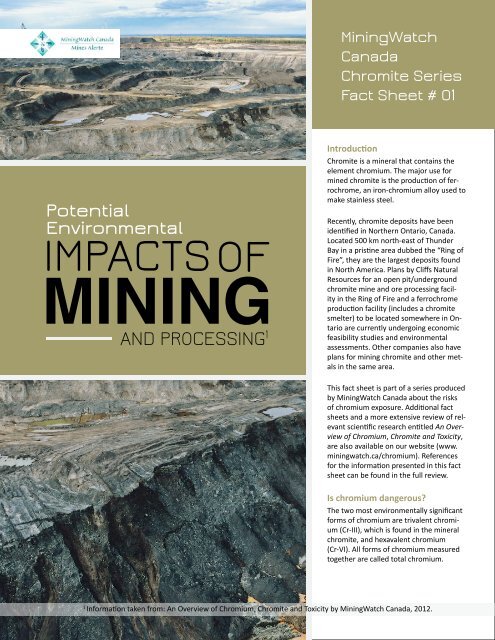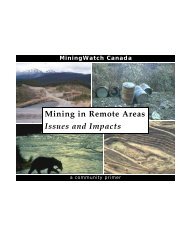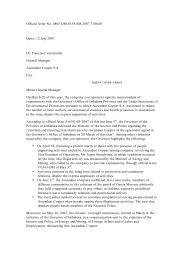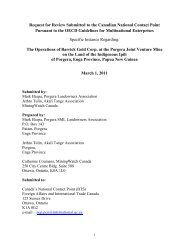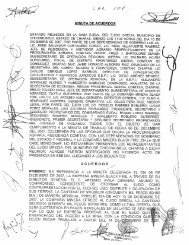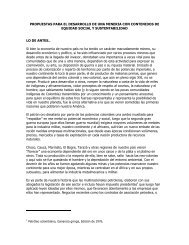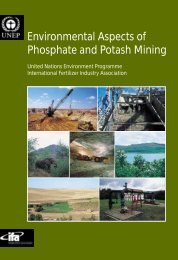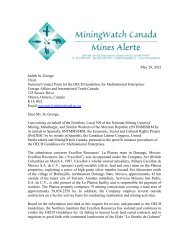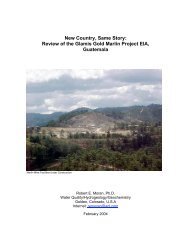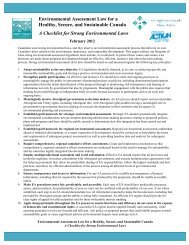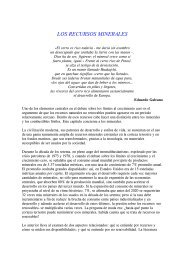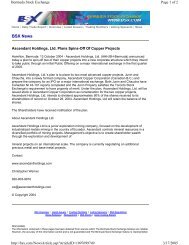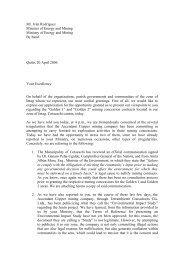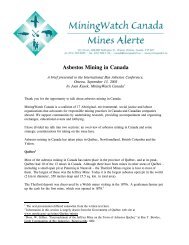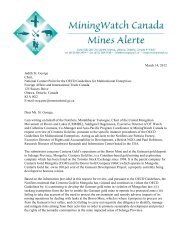Potential impacts of mining and processing chromite. Fact Sheet 1
Potential impacts of mining and processing chromite. Fact Sheet 1
Potential impacts of mining and processing chromite. Fact Sheet 1
You also want an ePaper? Increase the reach of your titles
YUMPU automatically turns print PDFs into web optimized ePapers that Google loves.
MiningWatch<br />
Canada<br />
Chromite Series<br />
<strong>Fact</strong> <strong>Sheet</strong> # 01<br />
<strong>Potential</strong><br />
Environmental<br />
IMPACTSOF<br />
MINING<br />
AND PROCESSING 1<br />
Introduction<br />
Chromite is a mineral that contains the<br />
element chromium. The major use for<br />
mined <strong>chromite</strong> is the production <strong>of</strong> ferrochrome,<br />
an iron-chromium alloy used to<br />
make stainless steel.<br />
Recently, <strong>chromite</strong> deposits have been<br />
identified in Northern Ontario, Canada.<br />
Located 500 km north-east <strong>of</strong> Thunder<br />
Bay in a pristine area dubbed the “Ring <strong>of</strong><br />
Fire”, they are the largest deposits found<br />
in North America. Plans by Cliffs Natural<br />
Resources for an open pit/underground<br />
<strong>chromite</strong> mine <strong>and</strong> ore <strong>processing</strong> facility<br />
in the Ring <strong>of</strong> Fire <strong>and</strong> a ferrochrome<br />
production facility (includes a <strong>chromite</strong><br />
smelter) to be located somewhere in Ontario<br />
are currently undergoing economic<br />
feasibility studies <strong>and</strong> environmental<br />
assessments. Other companies also have<br />
plans for <strong>mining</strong> <strong>chromite</strong> <strong>and</strong> other metals<br />
in the same area.<br />
This fact sheet is part <strong>of</strong> a series produced<br />
by MiningWatch Canada about the risks<br />
<strong>of</strong> chromium exposure. Additional fact<br />
sheets <strong>and</strong> a more extensive review <strong>of</strong> relevant<br />
scientific research entitled An Overview<br />
<strong>of</strong> Chromium, Chromite <strong>and</strong> Toxicity,<br />
are also available on our website (www.<br />
<strong>mining</strong>watch.ca/chromium). References<br />
for the information presented in this fact<br />
sheet can be found in the full review.<br />
Is chromium dangerous?<br />
The two most environmentally significant<br />
forms <strong>of</strong> chromium are trivalent chromium<br />
(Cr-III), which is found in the mineral<br />
<strong>chromite</strong>, <strong>and</strong> hexavalent chromium<br />
(Cr-VI). All forms <strong>of</strong> chromium measured<br />
together are called total chromium.<br />
1<br />
Information taken from: An Overview <strong>of</strong> Chromium, Chromite <strong>and</strong> Toxicity by MiningWatch Canada, 2012.
Too much Cr-III can be toxic to plants <strong>and</strong> animals. Human activities such as <strong>chromite</strong><br />
<strong>mining</strong> <strong>and</strong> ferrochrome manufacture can convert Cr-III into Cr-VI, which is also toxic <strong>and</strong><br />
is known to cause cancer. Cr-VI can more easily move into the cells <strong>of</strong> plants, animals <strong>and</strong><br />
micro-organisms, so it has a greater potential for toxicity.<br />
Though the intent <strong>of</strong> <strong>chromite</strong> <strong>mining</strong> is to remove the <strong>chromite</strong> from the ore for production<br />
<strong>of</strong> ferrochrome, the process is not 100% efficient, so <strong>mining</strong> <strong>and</strong> smelting wastes<br />
including dust, wastewater, tailings, waste rock <strong>and</strong> slag (produced during ferrochrome<br />
separation from the ore) can still contain chromium, including Cr-VI. Other heavy metals<br />
<strong>and</strong> chemicals <strong>of</strong> concern may also be in the wastes. As with other types <strong>of</strong> <strong>mining</strong> wastes,<br />
<strong>chromite</strong> mine wastes have the potential to cause serious environmental contamination.<br />
This has occurred in places around the world where these wastes have been inadequately<br />
managed.<br />
In 1995, ferrochrome <strong>and</strong><br />
stainless steel plants in Finl<strong>and</strong><br />
emitted 14.58 tonnes <strong>of</strong><br />
chromium into air, 4.6 tonnes<br />
into water <strong>and</strong> 1330 tonnes<br />
onto l<strong>and</strong> (Mukherjee 1998).<br />
How can chromium affect ecosystem health?<br />
Soil, sediment, water, air <strong>and</strong> living things can all become contaminated with chromium<br />
as a result <strong>of</strong> <strong>mining</strong> <strong>and</strong> other industrial activities. Because there has never been a<br />
major <strong>chromite</strong> mine in North America, most <strong>of</strong> the concerns about chromium toxicity in<br />
Canada <strong>and</strong> the US (including the film Erin Brokovich) are not about <strong>chromite</strong> <strong>mining</strong> but<br />
“downstream” industrial uses <strong>of</strong> chromium. Based on what we know about chromium <strong>and</strong><br />
experiences in other parts <strong>of</strong> the world, we know that <strong>mining</strong> <strong>and</strong> <strong>processing</strong> <strong>chromite</strong> also<br />
poses significant risks <strong>of</strong> contamination if poorly managed.<br />
Depending on environmental conditions, chromium can be converted from Cr-VI to Cr-III<br />
or vice versa <strong>and</strong> both types <strong>of</strong> conversions can occur in the same system. These natural<br />
processes are influenced by complex physical, biological <strong>and</strong> chemical factors such as soil<br />
type, mineral content, water characteristics, <strong>and</strong> biological interactions.<br />
Soil <strong>and</strong> Plants<br />
Relatively small amounts <strong>of</strong> Cr-VI (1-10 mg/kg) <strong>and</strong> Cr-III (25-100 mg/kg) can negatively<br />
impact the number, type, health <strong>and</strong> activity <strong>of</strong> soil organisms <strong>and</strong> so impact the health <strong>of</strong><br />
the soil ecosystem. Soil organisms play crucial roles in developing o soil structure <strong>and</strong> the<br />
cycling <strong>of</strong> organic matter <strong>and</strong> nutrients.<br />
Plants can accumulate Cr-III <strong>and</strong> Cr-VI from soil, sediment, water <strong>and</strong> from dust deposited<br />
onto leaves. It is normal for small amounts <strong>of</strong> Cr-III to be found in plants <strong>and</strong> many accumulate<br />
only a little chromium, most <strong>of</strong> which is stored in the roots. However, some species<br />
can store high amounts <strong>of</strong> chromium in roots <strong>and</strong> above-ground parts. These “hyperaccumulators”<br />
can be aquatic or l<strong>and</strong> plants, <strong>and</strong> include duckweed (Spirodela polyrhiza),<br />
mustard greens (Brassica juncea) <strong>and</strong> ragweed (Ambrosia artemisiifolia).<br />
Exposure to excess Cr-III or Cr-VI can negatively affect plant health <strong>and</strong> survival. Sensitivity<br />
<strong>and</strong> effects can be very different between plant species <strong>and</strong> soil types, which makes predicting<br />
toxicity difficult. Toxic effects shown on experimental exposure to plants include:<br />
• reduced or delayed growth;<br />
• yellow leaves caused by decreased chlorophyll;<br />
• narrow leaves;<br />
• small root systems;<br />
• damage to root membranes <strong>and</strong> decreased ability to take up water;<br />
• changes in uptake <strong>and</strong> storage <strong>of</strong> nutrients (nitrogen, calcium etc.);<br />
• decreased or no seed germination;<br />
• decreased seed yield;<br />
• wilting;<br />
• death
Some studies suggest that plants convert all Cr-VI into Cr-III, but other studies have found<br />
Cr-VI <strong>and</strong> its intermediate forms, Cr-V <strong>and</strong> Cr-IV, persist in plants <strong>and</strong> algae. As Cr-VI, Cr-V<br />
<strong>and</strong> Cr-IV are involved in chromium’s most toxic effects in humans <strong>and</strong> some other animals,<br />
their presence in plants has the potential to threaten ecological health.<br />
Terrestrial Life<br />
Information on the doses <strong>of</strong> chromium in water or food that cause health problems in<br />
mammals come mostly from toxicology tests done in the lab on mice <strong>and</strong> rats. Effects observed<br />
on animals in experimental doses through food, water or injection include: cancers,<br />
reproductive harm, behavioral changes, reduced growth <strong>and</strong> reduced survival. Very few<br />
field studies have been conducted about the effects <strong>of</strong> environmental chromium pollution<br />
on wildlife <strong>and</strong> we did not find any information directly relevant to potential <strong>impacts</strong> <strong>of</strong><br />
<strong>chromite</strong> <strong>mining</strong> <strong>and</strong> ferrochrome production on terrestrial wildlife.<br />
Aquatic Life<br />
Chromium in aquatic ecosystems can harm algae, aquatic plants, invertebrates <strong>and</strong> fish.<br />
The amount <strong>of</strong> chromium taken up <strong>and</strong> stored in living tissue <strong>and</strong> its effects depend on factors<br />
such as species, organism size, sex <strong>and</strong> developmental stage, water characteristics <strong>and</strong><br />
presence <strong>of</strong> other contaminants. Toxic effects include:<br />
Units <strong>of</strong> Measurement:<br />
1 million micrograms (ug)<br />
equals 1 gram.<br />
1 thous<strong>and</strong> milligrams (mg)<br />
equals 1 gram.<br />
• reduced growth (algae, plants, invertebrates <strong>and</strong> fish)<br />
• decrease in successful reproduction (invertebrates <strong>and</strong> fish)<br />
• DNA damage (fish)<br />
• reduced weights (fish)<br />
• decreased disease resistance (fish)<br />
• reduced survival (plants, invertebrates <strong>and</strong> fish)<br />
Studies have observed Cr-VI toxicity on algae <strong>and</strong> aquatic plants exposed to as little as<br />
1-10 ug/L <strong>and</strong> on invertebrates <strong>and</strong> fish exposed to as little as 10 ug/L. In fish, Cr-VI harms<br />
internal organs such as the liver <strong>and</strong> kidney. Chromium-III in water seems to be more toxic<br />
to fish than Cr-VI. It can decrease fertilization success, deposit onto gills which damages<br />
tissue <strong>and</strong> function <strong>and</strong> can cause death at relatively low doses. Chromium-III has caused<br />
toxic effects on fish at 5 ug/L, on invertebrates at 44 ug/L <strong>and</strong> on algae at 320 ug/L.<br />
Chromium in mine <strong>and</strong> ferrochrome wastes can be much higher than the concentrations<br />
known to harm aquatic life. At an open pit <strong>chromite</strong> mine in India, Cr-VI in mine effluents<br />
ranged from 20 ug/L to 120 ug/L <strong>and</strong> in mine seepage from 50 ug/L to 1220 ug/L. In a<br />
study testing ferrochrome slag from Turkey, 610 ug/L <strong>of</strong> Cr-VI leached from crushed slag<br />
<strong>and</strong> 3800 ug/L <strong>of</strong> Cr-VI leached from ground slag.<br />
Biomagnification<br />
Biomagnification is an increase in the concentration <strong>of</strong> contaminants at higher levels <strong>of</strong><br />
a food chain as predators eat contaminated food, retain the contaminants <strong>and</strong> then pass<br />
them on to higher level predators. Toxic compounds that biomagnfy can seriously threaten<br />
ecosystem health. Chromium however, is not considered likely to biomagnify in aquatic<br />
<strong>and</strong> terrestrial food chains. A number <strong>of</strong> studies have actually found lower chromium<br />
concentrations in aquatic creatures higher up the food chain <strong>and</strong> there is no documented<br />
evidence for biomagnification <strong>of</strong> chromium from soil to plant to animal. This conclusion,<br />
however, is based on very few studies <strong>of</strong> the risk <strong>of</strong> chromium in food chains, <strong>and</strong> evidence<br />
does exist for biomagnification <strong>of</strong> chromium from wetl<strong>and</strong> invertebrates to their<br />
predators - birds.<br />
What don’t we know about the ecosystem risks <strong>of</strong> chromium?<br />
The majority <strong>of</strong> toxicity studies about chromium <strong>and</strong> environmental effects have been conducted<br />
in labs, which don’t fully account for complex field conditions. Scientists acknowledge<br />
there is a need for more research regarding chromium uptake, effects <strong>and</strong> risks in<br />
freshwater <strong>and</strong> terrestrial wildlife. Some key areas <strong>of</strong> uncertainty <strong>and</strong> lack <strong>of</strong> information<br />
include the following:
1. Without site specific studies, toxicity predictions are limited because<br />
responses to chromium vary widely among different soil types, water<br />
characteristics, plant <strong>and</strong> animal species.<br />
2. It is unclear whether Cr-III or Cr-VI is more toxic to plants.<br />
3. It is unclear what forms <strong>of</strong> chromium are present in plants after uptake<br />
<strong>and</strong> what risks these may pose to plant consumers.<br />
4. Chromium exposure can change the nutrient uptake <strong>of</strong> plants, <strong>and</strong> the<br />
potential health effects <strong>of</strong> this for plant consumers have not been<br />
investigated.<br />
5. Recent research suggests that st<strong>and</strong>ard tests may be underestimating<br />
Cr-III toxicity to algae.<br />
6. Chromium is considered not likely to biomagnify up aquatic <strong>and</strong> terres<br />
trial food chains, but this is based on few studies.<br />
Does the government regulate chromium in the environment?<br />
Both the Canadian <strong>and</strong> Ontario governments have st<strong>and</strong>ards for allowable chromium levels<br />
in the environment (Table 1). In recent years governments have undertaken reviews to<br />
update some chromium regulations, many <strong>of</strong> which have resulted in stricter st<strong>and</strong>ards.<br />
Ferrochrome arc furnace dust is categorized as toxic waste in Canada (waste K091) <strong>and</strong><br />
must be treated before disposal in order to prevent leaching <strong>of</strong> toxins into the environment.<br />
Canadian <strong>and</strong> Ontarian hazardous waste guidelines require that wastes leach no<br />
more than 5 000 ugCr/L, a limit which is less stringent than a number <strong>of</strong> other countries<br />
<strong>and</strong> does not address allowable Cr-VI levels separately.<br />
The Canadian Interim Sediment Quality Guideline for bioavailable total chromium is 37.3<br />
mg/kg <strong>of</strong> dry sediment, while the Probable Effects Level (for aquatic creatures) for bioavailable<br />
total chromium is 90 mg/kg. Chromium-VI can be present in the top layer <strong>of</strong> sediment<br />
when the overlying water contains oxygen, but no guideline has been established for Cr-VI<br />
in sediment. The Ontario Contaminated Site Condition St<strong>and</strong>ard for total chromium in<br />
sediment is set at the upper limit <strong>of</strong> typical sediment concentration in the province.<br />
Canada has set Quality Criteria for agricultural irrigation water <strong>and</strong> livestock water. The<br />
Canadian Water Quality Guideline for the Protection <strong>of</strong> Freshwater Aquatic Life for Cr-VI is<br />
based on toxicity to a sensitive invertebrate (Ceriodaphnia dubia) <strong>and</strong> the interim guideline<br />
for Cr-III is based on toxicity to rainbow trout (Oncorhynchus mykiss). There are currently<br />
no tissue residue guidelines for the protection <strong>of</strong> animals <strong>and</strong> people who consume fish.<br />
Based on plant contact with soil, the Canadian Provisional Guideline for the protection <strong>of</strong><br />
environmental health is 0.4 mgCr-VI/kg for agricultural soils, <strong>and</strong> 1.4 mgCr-VI/kg for industrial<br />
<strong>and</strong> commercial soils. Canada’s chromium soil guidelines for the protection <strong>of</strong> environmental<br />
<strong>and</strong> human health are generally stricter than soil st<strong>and</strong>ards in other countries.<br />
The upper range <strong>of</strong> typical Ontario chromium concentrations in uncontaminated soils are<br />
slightly higher than the Canadian guidelines, thus the Ontario Site Condition Soil St<strong>and</strong>ards<br />
have set limits that allow more chromium than the Canadian guidelines.<br />
The federal Metal Mine Effluent Regulations do not set a limit for chromium in effluent being<br />
discharged into the environment. The effluent is required to pass an acute lethality test<br />
for rainbow trout, which means that it cannot kill more than 50% <strong>of</strong> the fish tested within<br />
96 hours.<br />
There are no federal Air Quality Guidelines for the protection <strong>of</strong> human health <strong>and</strong> the<br />
environment. Ontario has environmental air regulations set for the protection <strong>of</strong><br />
human health.
Table 1 Canadian <strong>and</strong> Ontarian Regulations <strong>and</strong> Guidelines for chromium in the environment.<br />
CAN is Canada. ON is Ontario. ug = microgram = 1 000 000 grams. na is not applicable<br />
Limit Total Cr Cr‐III Cr‐VI<br />
Freshwater (ug/L)1 2<br />
CAN & ON: Water Quality Guidelines for Protection <strong>of</strong> Aquatic Life ‐ 8.9 1<br />
CAN: livestock Water Interim Quality Criteria ‐ 50 50<br />
CAN: irrigation Water Interim Quality Criteria ‐ 4.9 8<br />
ON: non‐potable Groundwater St<strong>and</strong>ard 810 ‐ 140<br />
ON: non‐potable Groundwater St<strong>and</strong>ard in shallow soil or within 30m <strong>of</strong> 640 ‐ 110<br />
water body<br />
Sediment (mg/g dry weight)1 2<br />
CAN: Interim Quality Guideline 37.3 ‐ ‐<br />
CAN: Probable Effects Level 90<br />
ON: Contaminated Site Condition St<strong>and</strong>ard 26<br />
Soils (mg/kg)1 2<br />
CAN: Guideline for protection <strong>of</strong> environmental <strong>and</strong> human health for 64 ‐ 0.4<br />
agricultural, residential/parkl<strong>and</strong>s<br />
CAN: Guideline for the protection <strong>of</strong> environmental <strong>and</strong> human health for 87 ‐ 1.4<br />
industrial <strong>and</strong> commercial l<strong>and</strong>s<br />
ON: All l<strong>and</strong> uses, Soil St<strong>and</strong>ard for contaminated sites 160 ‐ ‐<br />
ON: All l<strong>and</strong> uses, medium – fine, coarse textured Soil St<strong>and</strong>ard for ‐ ‐ 10, 8<br />
contaminated sites<br />
ON:<br />
70 ‐ 0.66<br />
Residential/Parkl<strong>and</strong>/Institutional/Industrial/Commercial/Community<br />
property use Soil St<strong>and</strong>ard for contaminated sites within 30m <strong>of</strong> water<br />
body<br />
ON: Agricultural or Other property use Soil St<strong>and</strong>ard for contaminated 67 ‐ 0.66<br />
sites within 30m <strong>of</strong> water body, potable groundwater condition<br />
Environmental Air (ug/m 3 )3 Cr‐0, II, III Cr‐VI PM 10 Cr‐VI TSP<br />
ON: 24‐hr average Ambient Air Quality Criterion set in 1982 (Cr‐II, III) 1.5 ‐ ‐<br />
ON: 0.5‐hr average St<strong>and</strong>ard based on Cr‐III respiratory effects, effective 1.5 na na<br />
2016<br />
ON: 24‐hour average Air St<strong>and</strong>ard <strong>and</strong> Ambient Air Quality Criterion 0.5 na na<br />
based on Cr‐III respiratory effects, effective 2016<br />
ON: 24‐hr average Ambient Air Quality Criterion, based on Cr‐VI<br />
na 0.00035 0.0007<br />
carcinogenicity, effective 2016<br />
ON: annual Ambient Air Quality Criterion, based on Cr‐VI carcinogenicity, na 0.00007 0.00014<br />
effective 2016<br />
ON: 0.5‐hr average Air St<strong>and</strong>ard, based on Cr‐VI carcinogenicity, effective na ‐ 0.002<br />
2016<br />
ON: annual Air St<strong>and</strong>ard, based on Cr‐VI)‐ carcinogenicity, effective 2016 na ‐ 0.00014<br />
Waste (ug/L)4 5<br />
CAN: Hazardous Waste Transport Regulation<br />
ON: Hazardous Waste Quality Criteria<br />
5 000 ‐ ‐<br />
Dhal B, Thatoi H, 1 Das http://ceqg‐rcqe.ccme.ca/<br />
N, P<strong>and</strong>ey BD. 2010. Reduction <strong>of</strong> hexavalent chromium by Bacillus sp. isolated<br />
from <strong>chromite</strong> mine soils <strong>and</strong> characterization <strong>of</strong> reduced product. J Chem Technol Biotechnol. 85, 1471–1479.<br />
2 http://www.ene.gov.on.ca/stdprodconsume/groups/lr/@ene/@resources/documents/resource/stdprod_086518.pdf<br />
3 http://www.downloads.ene.gov.on.ca/envision/env_reg/er/documents/2011/010‐6353.pdf<br />
4 http://laws‐lois.justice.gc.ca/eng/regulations/SOR‐2005‐149/page‐19.html#h‐34<br />
5 http://www.e‐laws.gov.on.ca/html/regs/english/elaws_regs_900347_e.htm#BK31<br />
Mukherjee AB. 1998. Chromium in the environment <strong>of</strong> Finl<strong>and</strong>. The Science <strong>of</strong> the Total Environment. 217, 9-19.<br />
Pumure I, Sithole SD, Kahwai SG. 2002. Characterisation <strong>of</strong> particulate matter emissions from the Zimbabwe Mining <strong>and</strong><br />
Smelting Company (ZIMASCO) Kwekwe Division (Zimbabwe): a ferrochrome smelter. Environmental Monitoring<br />
<strong>and</strong> Assessment. 87, 111–121.<br />
Tiwary RK, Dhakate R, An<strong>and</strong>a Rao V, Singh VS. 2005. Assessment <strong>and</strong> prediction <strong>of</strong> contaminant migration in ground water from<br />
<strong>chromite</strong> waste dump. Environ. Geol. 48, 420–429.<br />
2<br />
http://ceqg-rcqe.ccme.ca/<br />
3<br />
http://www.ene.gov.on.ca/stdprodconsume/groups/lr/@ene/@resources/documents/resource/stdprod_086518.pdf<br />
4<br />
http://www.downloads.ene.gov.on.ca/envision/env_reg/er/documents/2011/010-6353.pdf<br />
5<br />
http://laws-lois.justice.gc.ca/eng/regulations/SOR-2005-149/page-19.html#h-34<br />
6<br />
http://www.e-laws.gov.on.ca/html/regs/english/elaws_regs_900347_e.htm#BK31


